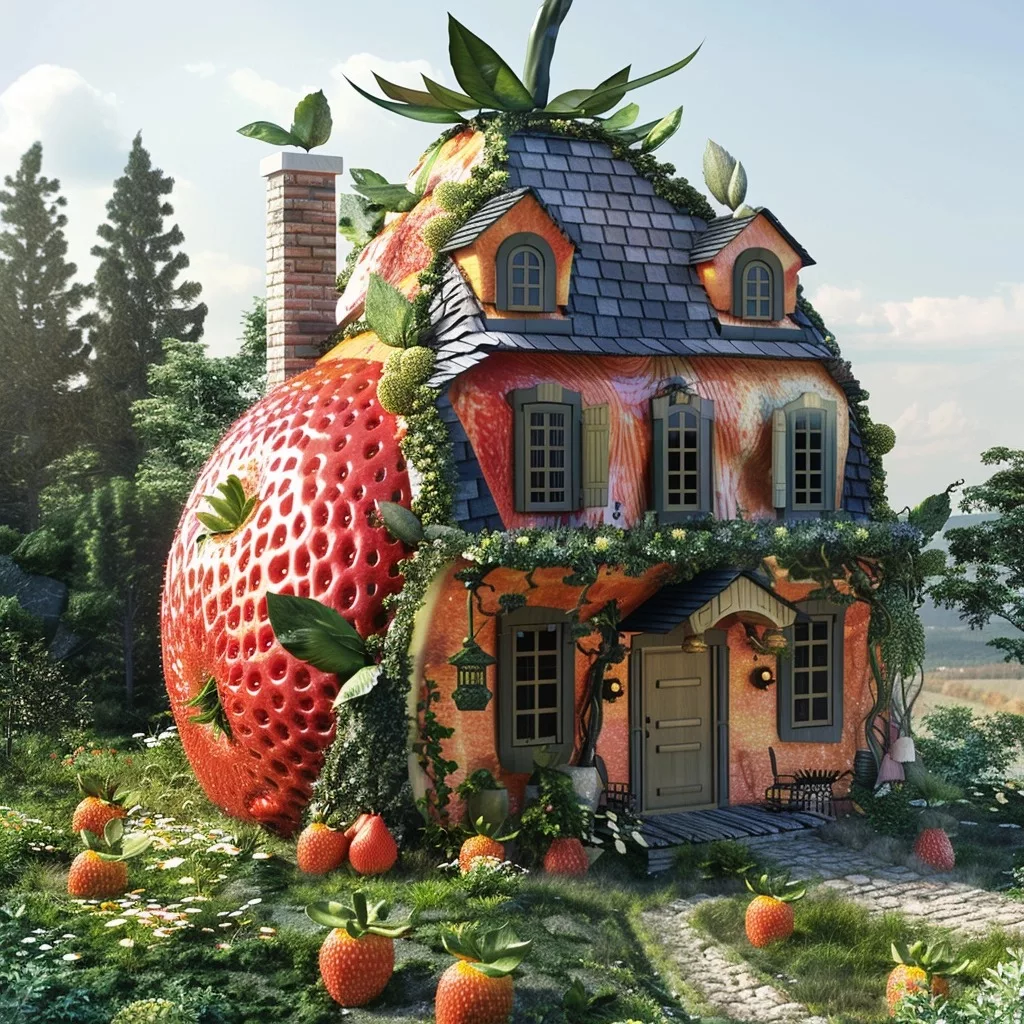
A fruit house, also known as a fruit farm or a glasshouse, is a specialized enclosed structure designed for growing and cultivating fruit trees and plants. Unlike traditional orchards, fruit houses offer unique features that enhance fruit production and provide a controlled environment for plant growth. These structures have become increasingly popular among farmers and horticulturists due to their numerous advantages. In this article, we will discuss the unique features of a fruit house and why it has become an essential tool for modern agriculture.
Contents
- 0.1 Temperature and Humidity Control
- 0.2 Protected Environment
- 0.3 Extended Growing Season
- 0.4 Vertical Trellising
- 1 Benefits of Having a Fruit House
- 2 Design Ideas for a Fruit House
- 3 Maintenance Tips for Fruit Houses
- 4 Choosing the Right Location for Your Fruit House
- 5 Popular Fruit Varieties to Grow in a Fruit House
- 6 Maximizing Space in Your Fruit House
- 7 Harvesting and Storing Fruits from Your Fruit House
- 8 Environmental Impact of Fruit Houses
- 9 Cost Considerations for Building a Fruit House
- 10 Conclusion
Temperature and Humidity Control
One of the most significant advantages of a fruit house is its ability to control temperature and humidity levels. These environmental controls allow for precise regulation of the internal climate, creating optimal growing conditions for specific fruit varieties. This feature is particularly beneficial for regions with extreme weather conditions, as fruit houses can maintain a stable temperature and humidity despite external fluctuations.
The ideal temperature and humidity levels vary depending on the type of fruits being grown. For example, citrus fruits require warmer temperatures between 70-85°F (21-29°C), while apples and pears prefer cooler temperatures between 50-68°F (10-20°C). With a fruit house, farmers can create and maintain these specific conditions, ensuring the success of their crops.
Additionally, controlling humidity levels is crucial for preventing fungal diseases and maintaining healthy plant growth. Too much moisture in the air can lead to mold and mildew, while too little can cause plants to dry out and wilt. With a fruit house, farmers can achieve the perfect balance of moisture, promoting optimal fruit growth and quality.

Protected Environment
Another significant advantage of a fruit house is its ability to protect plants from harsh weather conditions. Strong winds, hail, and excessive rainfall can damage crops and delay harvests in open-field farming. However, with a fruit house, farmers can mitigate these risks and ensure the continuous growth of their fruits.
Moreover, fruit houses act as barriers against pests, diseases, and birds, reducing the need for harmful pesticides and other treatments. This not only benefits the environment but also saves farmers time and money. With a protected environment, farmers can also experiment with different pest control methods, such as biological controls, without any risk to their crops.

Extended Growing Season
With climate change and unpredictable weather patterns, the traditional growing season for fruits has become shorter. However, with a fruit house, farmers can extend the growing season and cultivate fruits year-round. The controlled environment within the structure allows for the cultivation of fruit varieties that may not thrive in the local climate outdoors.
For example, farmers in colder climates can grow tropical fruits such as mangoes and papayas inside a fruit house, providing consumers with fresh produce even during the winter months. Similarly, those in hotter regions can cultivate fruits like apples and cherries, which typically require cooler temperatures.
Furthermore, with an extended growing season, farmers can stagger their harvests and supply fruits to the market throughout the year, increasing their profits and meeting consumer demand.
Vertical Trellising
Fruit houses often incorporate vertical trellising systems that support the growth of fruit trees and vines. This technique involves using stakes or wires to support the branches of fruit trees, training them to grow vertically rather than horizontally. This method offers several benefits, making it a popular feature in fruit houses.
Firstly, vertical trellising improves air circulation, minimizing the risk of fungal diseases and promoting healthy plant growth. It also allows for better light penetration, ensuring that all fruits receive adequate sunlight, which is essential for photosynthesis and fruit development.
Secondly, trellising maximizes space utilization, enabling farmers to grow more fruits in a smaller area. This is particularly useful for urban or small-scale farmers who may have limited space. By utilizing vertical space, they can increase their fruit production without having to expand their land.
Finally, vertical trellising makes harvesting easier, as the fruits are at a comfortable height, eliminating the need for ladders or other equipment. This reduces the risk of accidents and injuries, making the process more efficient and less labor-intensive.
Benefits of Having a Fruit House
Having discussed the unique features of a fruit house, let us now explore the various benefits of having one on your property. From increased productivity to improved fruit quality, a fruit house can significantly impact your farming operations.

Protection from Extreme Weather
As mentioned earlier, a fruit house provides a protected environment for plants, shielding them from harsh weather conditions. This feature is particularly essential for regions prone to strong winds, heavy rain, or hail, which can damage crops and reduce yields. With a fruit house, farmers can rest assured that their plants are safe and continue to grow without any interruptions.
Additionally, the controlled environment within a fruit house can help mitigate the effects of droughts or floods, providing a consistent water supply to the fruits. This is especially helpful in areas with unreliable or limited rainfall, allowing farmers to continue their operations despite weather challenges.
Increased Productivity and Profitability
The combination of controlled environments, extended growing seasons, and vertical trellising leads to increased productivity and profitability for farmers. By creating optimal conditions for growth, fruit houses can significantly increase fruit yields, maximizing profits for farmers. Moreover, with an extended growing season, farmers can keep up with consumer demand and potentially earn higher prices for their produce.
Additionally, by utilizing vertical space, farmers can grow a larger number of fruits in a smaller area, reducing the cost of land and increasing overall productivity. This is particularly beneficial for small-scale farmers or those with limited land, as they can make the most of their available resources.

Improved Fruit Quality
Fruit houses provide a controlled environment for plant growth, resulting in better quality fruits. With precise temperature and humidity regulation, fruits can reach their full potential, offering a desirable taste, texture, and appearance. Furthermore, with protection from pests and diseases, fruits are less likely to have blemishes or deformities, making them more marketable and commanding a higher price.
Reduced Use of Chemicals
By protecting plants from pests and diseases, fruit houses reduce the need for harmful chemicals such as pesticides and fungicides. This not only benefits the environment but also promotes healthier produce for consumption. Furthermore, with the use of biological controls and other sustainable methods, farmers can reduce their reliance on chemical treatments, leading to safer and more eco-friendly farming practices.
Design Ideas for a Fruit House
When it comes to designing a fruit house, there are several factors to consider, including the type of fruits being grown, the size and location of the structure, and the budget. Here are some design ideas to help you create an efficient and effective fruit house for your farming needs.

Choose the Right Structure
The first step in designing a fruit house is choosing the right structure for your needs. There are various options available, including high tunnel greenhouses, low tunnels, and hoop houses. High tunnels, also known as caterpillar tunnels, are large, arched structures made of metal frames and polyethylene film. They are suitable for commercial farming and can accommodate a wide variety of fruits.
Low tunnels are similar to high tunnels but are usually smaller in size and do not have a metal frame. Instead, they use hoops made of PVC pipes covered with plastic sheeting. Low tunnels are ideal for small-scale farmers or hobbyists who want to grow a few fruits for personal consumption.
Hoop houses are lightweight, portable structures made of metal frames and polyethylene film. They are smaller than high tunnels and are suitable for temporary use or for growing seedlings before transplanting them to the field.
Consider the Location and Orientation
The location and orientation of the fruit house are crucial for its success. Ideally, the structure should be built on flat or slightly elevated ground, with good access to water and electricity. It should also receive ample sunlight throughout the day, as fruits require a minimum of six hours of direct sunlight daily.
The orientation of the structure should be such that the longest side faces south to maximize sunlight exposure. Additionally, make sure to leave enough space around the fruit house for ventilation and movement of equipment.

Optimize Air Circulation
Proper air circulation is essential for the health of plants and fruits. When designing a fruit house, ensure that there are enough vents and openings to enable air to flow freely. This will prevent the build-up of moisture and reduce the risk of fungal diseases. You can also install fans or other ventilation systems to promote air circulation, especially in high tunnels or hoop houses.
Incorporate Irrigation Systems
Fruits require a consistent water supply for optimal growth and development. Therefore, it is essential to incorporate an irrigation system into your fruit house design. Depending on your budget and the size of your structure, you can choose from drip irrigation, sprinkler systems, or manual watering methods. Automated systems are more convenient and can save farmers time and effort, but they may be more expensive to install and maintain.
Choose the Right Material
Choosing the right material for your fruit house is crucial for its longevity and effectiveness. While polyethylene film is the most commonly used material for fruit houses, it may not be suitable for all types of fruits. For instance, if you are growing soft fruits such as strawberries, you may need to use a softer material to ensure there is no damage to the fruits when they come into contact with the covering.
Maintenance Tips for Fruit Houses
To ensure the success of your fruit house, regular maintenance is essential. Here are some tips to help you keep your structure in top condition.
Clean and Disinfect Regularly
Cleanliness is crucial for a healthy fruit house. Regularly sweep away debris and remove any dead or infected plants to prevent the spread of diseases. Disinfect the structure periodically to eliminate any harmful bacteria or fungi that may have accumulated over time. This will help keep your fruits healthy and promote optimal growth.

Check for Damage
Perform regular checks for any signs of damage to your fruit house. Look for tears or holes in the covering, cracks or dents in the frames, or any other structural issues. Repair any damage immediately to prevent further deterioration and ensure the longevity of your structure.
Monitor for Pests and Diseases
Despite the protective features of a fruit house, pests and diseases can still find their way inside. Regular monitoring for signs of infestation or infection is crucial to catch any issues early on and address them before they become widespread. Employing natural methods of pest control, such as introducing beneficial insects, can also help keep pests under control.
Maintain Proper Moisture Levels
As mentioned earlier, proper moisture levels are crucial for fruit growth. Monitor the humidity levels inside your fruit house and adjust accordingly. Excess moisture can lead to the growth of mold and mildew, while insufficient moisture can cause plants to dry out and wilt. Ensure there is adequate drainage to avoid waterlogging and maintain an optimal growing environment for your fruits.
Choosing the Right Location for Your Fruit House
Selecting the right location for your fruit house is essential for its success. Here are some factors to consider when deciding on the placement of your structure.
Climate
The climate of your region plays a significant role in determining the success of your fruit house. Ideally, it would be best if you chose a location with a moderate climate, with neither extreme heat nor cold. This will minimize the energy required to regulate the internal temperature and humidity, reducing operational costs.
Access to Water and Electricity
A constant water supply is essential for the growth of fruits. Therefore, it is crucial to select a location that has easy access to water. If you plan on installing automated irrigation systems, make sure to have a water source nearby.
Similarly, access to electricity is necessary for powering any environmental control systems, lighting, or other equipment you may use in your fruit house. Choose a location where you can easily connect to a power source without having to lay down long electrical cords.
Adequate Sunlight
Fruits require a minimum of six hours of direct sunlight daily for optimal growth. Therefore, it is essential to select a location that receives ample sunlight throughout the day. Avoid placing your fruit house near tall buildings or trees that may cast shadows and block the sun’s rays.
Soil Quality
While a fruit house is an enclosed structure, the soil on which it stands is still crucial for plant growth. Choose a location with good soil quality that is free from contaminants and has sufficient nutrients for plants.
Popular Fruit Varieties to Grow in a Fruit House
There are many types of fruits that you can grow in a fruit house, depending on your region, climate, and personal preferences. Here are some popular varieties that thrive in a controlled environment.
Citrus Fruits
Citrus fruits such as oranges, lemons, and grapefruits are tropical fruits that require warm temperatures and high humidity levels to thrive. Therefore, a fruit house is an ideal place to grow these fruits, especially in colder regions. Citrus fruits are also susceptible to frost and wind damage, making a fruit house an excellent option for their protection.
Apples and Pears
Apples and pears are temperate fruits that require cool temperatures and moderate humidity levels to grow. In regions with hot summers, a fruit house can provide the necessary shelter and temperature control to successfully cultivate these fruits. You can also find varieties that do well in the spring and fall, giving farmers the opportunity to grow these fruits year-round.
Grapes
Grapes are another popular fruit that does well in a fruit house. The vertical trellising feature of these structures is particularly beneficial for grapes, as it allows for maximum airflow and light penetration. Moreover, a fruit house protects grapes from birds and pests that may damage the fruits.
Berries
Strawberries, blueberries, and raspberries are among the most popular types of berries grown in fruit houses. These fruits require a specific level of humidity and protection from wind and rain, making a fruit house an ideal environment for their cultivation. Moreover, the vertical trellising feature allows for better space utilization and easier harvesting of these small fruits.
Maximizing Space in Your Fruit House
When designing and maintaining a fruit house, it is essential to make the most of the available space. Here are some tips to help you maximize space in your structure.
Utilize Vertical Space
Vertical trellising is a game-changer when it comes to maximizing space in a fruit house. By training plants to grow upward, you can utilize the vertical space in your structure without taking up too much horizontal space. This is particularly beneficial if you have a smaller fruit house or want to grow a larger number of fruits.
Plan Your Layout Carefully
Before planting your fruits, carefully plan the layout of your fruit house to make the most of the available space. Group plants with similar environmental requirements together, so you can control the temperature and humidity more efficiently. Leave enough space between rows for easy movement and ventilation.
Use Lightweight Containers
Using lightweight containers such as pots and buckets is an excellent way to maximize space in your fruit house. These containers can be stacked on shelves or hung from the ceiling, leaving ample floor space for movement and storage of equipment.
Stagger Planting and Harvesting Times
Staggering planting and harvesting times is another effective way to maximize space in a fruit house. By staggering, you can continuously grow new plants while harvesting mature ones, allowing for a steady supply of fruits throughout the year.
Harvesting and Storing Fruits from Your Fruit House
Harvesting and storing fruits from your fruit house requires careful planning and proper techniques to maintain the quality of your produce. Here are some tips to help you get the most out of your harvest.
Timing is Crucial
Timing is crucial when it comes to harvesting fruits from your fruit house. Different fruits have different maturity periods, and picking them at the right time is essential for optimal flavor and texture. Generally, fruits are ready to be harvested when they are fully ripe and easily detach from the plant. You can also check for color changes or use a refractometer to measure sugar levels to determine if the fruits are ready.
Harvest Early in the Day
It is best to harvest fruits early in the day when the temperature is relatively cool. This will ensure that the fruits do not lose too much moisture during transport and storage. Avoid harvesting during the hottest part of the day, as this can cause wilting and damage to the fruits.
Store Fruits Properly
Once you have harvested your fruits, it is crucial to store them properly to maintain their quality and prolong their shelf life. Some fruits, such as grapes and berries, can be stored in the refrigerator, while others, such as apples and pears, require a cool, dark place. Make sure to research the storage requirements for each type of fruit you are growing to ensure they stay fresh for longer.
Environmental Impact of Fruit Houses
As with any farming practice, it is essential to consider the environmental impact of fruit houses. While they offer numerous benefits for farmers, they also have some drawbacks that must be considered.
Energy Consumption
Controlling the temperature and humidity levels inside a fruit house requires a significant amount of energy. Most fruit houses rely on fossil fuels to power heaters, fans, and other environmental control systems, leading to carbon emissions. However, advancements in technology have led to the development of more energy-efficient structures that utilize renewable energy sources.
Land Utilization
Fruit houses often require a substantial amount of land for construction, especially for commercial-scale operations. This can lead to deforestation or the conversion of natural habitats into agricultural land, impacting local ecosystems and biodiversity. Farmers should consider sustainable land use practices and prioritize the conservation of natural areas when building fruit houses.
Water Usage
Growing fruits in a controlled environment like a fruit house typically requires more water compared to traditional outdoor farming methods. Water usage must be carefully monitored to prevent wastage and ensure efficient irrigation practices. Implementing water-saving technologies such as drip irrigation systems can help reduce water consumption and minimize the environmental impact of fruit houses.
Chemical Inputs
The use of pesticides, herbicides, and fertilizers in fruit houses can have negative consequences on the environment if not managed properly. Chemical runoff from these inputs can contaminate soil and water sources, leading to pollution and ecosystem damage. Farmers should adopt integrated pest management strategies and organic farming practices to minimize the reliance on synthetic chemicals and promote environmental sustainability.
Cost Considerations for Building a Fruit House
Building a fruit house involves various costs, including construction materials, equipment, utilities, and maintenance expenses. It is essential to carefully consider these financial aspects to ensure the economic viability of your fruit house project.
Initial Investment
The initial cost of constructing a fruit house can be significant, depending on the size, design, and materials used. Factors such as site preparation, foundation construction, framing, glazing, and environmental control systems all contribute to the overall expenses. Farmers should create a detailed budget and seek competitive quotes from suppliers and contractors to manage costs effectively.
Operational Costs
Operating a fruit house incurs ongoing expenses related to energy consumption, water usage, labor, and maintenance. Heating, cooling, and ventilation systems account for a significant portion of operational costs, especially in regions with extreme weather conditions. Farmers should implement energy-efficient technologies and practices to reduce utility bills and improve cost-effectiveness.
Return on Investment
Despite the initial and operational costs, a well-managed fruit house has the potential to generate a high return on investment through increased yields, extended growing seasons, and premium pricing for fresh, locally grown fruits. Farmers should conduct a thorough financial analysis to assess the profitability of their fruit house venture and make informed decisions regarding crop selection, marketing strategies, and sales channels.
Conclusion
In conclusion, fruit houses offer a controlled environment for cultivating a wide range of fruits, providing numerous benefits for farmers, including extended growing seasons, protection from adverse weather conditions, and higher yields. By incorporating unique features, utilizing space efficiently, selecting suitable fruit varieties, and implementing proper maintenance and harvesting practices, farmers can maximize the productivity and sustainability of their fruit houses. However, it is crucial to consider the environmental impact, cost considerations, and long-term financial implications of building and operating a fruit house. With careful planning, investment, and management, fruit houses can be a profitable and environmentally responsible solution for modern fruit cultivation.






